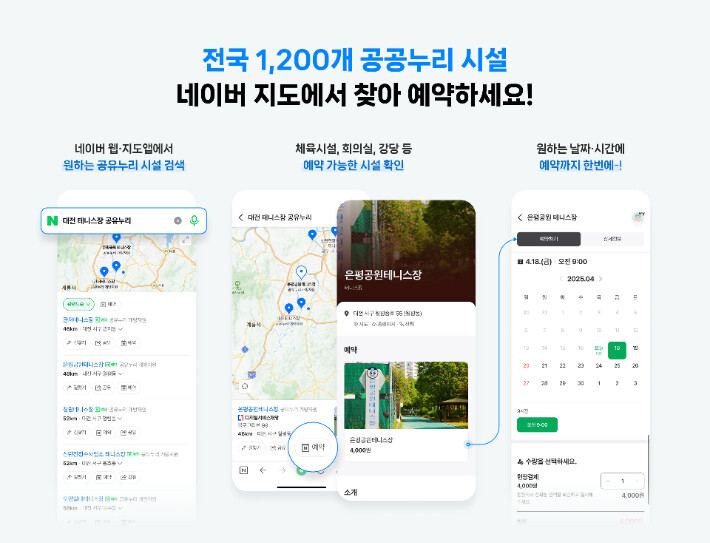
Naver, South Korea's leading internet portal, announced today a significant enhancement to public service accessibility by integrating the booking system for over 1,200 public sports and meeting facilities nationwide directly into its platform. This collaboration with the Ministry of the Interior and Safety will streamline the reservation process, previously exclusive to the government's "Shared Nuri" website, by making these facilities bookable through Naver's Place search and Maps application.
This integration significantly improves the convenience of reserving a wide range of publicly owned facilities managed by central government agencies, local municipalities, and public institutions across the country. Users will now be able to easily book various sports facilities, including approximately 1,000 venues such as soccer fields, futsal fields, and tennis courts, as well as community-oriented spaces like lecture halls, meeting rooms, and auditoriums, all within the familiar Naver ecosystem.
The user experience is designed to be intuitive and seamless. By searching for the name of a facility, such as "tennis court" or "meeting room," via the Naver web portal or the Naver Maps application, users will be presented with a list of available locations. They can then select their desired date and time and proceed with the booking directly through the Naver interface. This eliminates the need to navigate separate government websites and simplifies the entire reservation process.
Naver has been actively expanding its services by incorporating diverse public datasets into its Place and Maps platforms, with a consistent focus on enhancing users' location accessibility and travel safety. This latest integration of the public facility booking system underscores this commitment.
A notable example of Naver's accessibility-focused initiatives is the introduction of the "avoid stairs" route option in its Naver Maps pedestrian navigation service last year. This feature provides alternative routes for users who find it difficult or impossible to use stairs, ensuring a more inclusive and convenient way to reach their destinations. This functionality caters to individuals with mobility impairments, the elderly, and those with strollers, demonstrating Naver's understanding of diverse user needs.
Furthermore, Naver Maps provides timely and crucial safety information by displaying summarized alerts in card format directly on the map. This includes real-time flood warnings, dam discharge forecasts, and information about large-scale fires, sourced from various channels including local governments. This proactive dissemination of critical information empowers users to make informed decisions and enhances their safety and preparedness in emergency situations.
In addition to these features, Naver Maps also provides detailed information about 112 "barrier-free sharing trails" (Mujangae Nanumgil) across the country. These trails are specifically designed to be accessible to everyone, including individuals with disabilities, pregnant women, and the elderly, featuring deck roads and Hwangto (red clay) paved paths within forest environments. This initiative promotes inclusivity and allows a wider range of people to enjoy the natural beauty and health benefits of these trails.
The integration of the public facility booking system is expected to further solidify Naver's role as a central platform for accessing essential public services and information. By leveraging its extensive user base and user-friendly interface, Naver is making it easier for citizens to engage with and utilize public resources. This initiative aligns with the growing global trend of smart cities and digital governance, where technology is used to improve the efficiency and accessibility of public services.
Industry analysts note that Naver's continuous efforts to integrate public data and enhance accessibility features not only benefit its users but also contribute to the company's positive public image and its position as a socially responsible technology leader. By focusing on user convenience and inclusivity, Naver is setting a benchmark for other digital platforms and contributing to a more accessible and informed society.
The collaboration between Naver and the Ministry of the Interior and Safety is a significant step towards a more digitally integrated and user-centric public service ecosystem in South Korea. It is anticipated that this integration will increase the utilization of public facilities and enhance the overall quality of life for citizens by providing easier access to recreational and community spaces. Naver's proactive approach to incorporating public data and accessibility features demonstrates its commitment to serving the diverse needs of its user base and contributing to a more inclusive digital society. This move is likely to be welcomed by citizens across the country who will now benefit from the enhanced convenience and accessibility offered by this integration.
[Copyright (c) Global Economic Times. All Rights Reserved.]



























